Fee Fi Foe Film: UConn

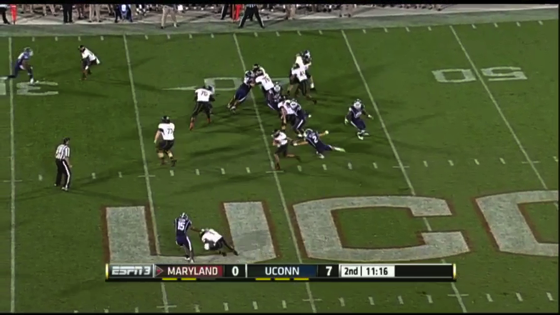
Welp.
Oh man, not again. Last week in this space, Akron's offense was represented by a tire fire, their defense a dumpster fire. Assumptions were made about the past having some bearing on the future, the Zips were dismissed as cannon fodder, and ... well, you saw how that turned out.
This week's opponent is UConn, which lost to Towson at home by 15 points in their first game, outgained by over 100 yards by an FCS opponent. After an oddly-timed bye week, the Huskies hosted Maryland last Saturday; once again, they lost the yardage battle by over 100 yards, and only a meaningless 75-yard TD pass with 22 seconds to play kept the score semi-respectable at 32-21. It could've been much, much worse:
- Maryland went for it on fourth-and-short twice in first quarter. Instead of spreading the field and either running to the outside or hitting a quick pass—both of which worked very well all game—they tried to attack the strength of UConn's defense and were stuffed on interior runs, failing both conversion attempts.
- The Terps drove all the way from their 17 down to UConn's 22 in the first quarter, only for an open screen pass to bounce off the hands of their running back and get intercepted by UConn's Taylor Mack. Maryland's three previous plays had gone for 26, 21, and 14 yards.
- By the end of the third quarter, Maryland would lose two fumbles by their running backs, one of which came after an easy ten-yard gain. The second led directly to a UConn field goal that would bring the Huskies within seven points.
When not shooting themselves in the foot, Maryland completely controlled the game, averaging 5.2 yards per rush and 9.9 yards per pass attempt. Take out the irrelevant late touchdown pass and UConn averaged 2.7 YPC (with five sacks removed!) and 6.1 YPA.
I promise to mock the Huskies as little as possible, however, after what went down last week. That said, I can only work with what I'm given, and for the second straight week what I'm given is, by all appearances, a really bad football team that lost to a I-AA squad.
OFFENSE

Quarterback Chandler Whitmer (via The UConn Blog)
Spread, Pro-Style, or Hybrid? Spread, mostly. UConn operated either from the gun or an ace set; no fullback got a snap that I saw (I charted until Maryland took a 19-point lead midway through the fourth quarter). They had one snap from what Madden/NCAA deem the "pro" set—the QB under center with two backs split behind him.
Basketball on Grass or MANBALL? Basketball on grass. UConn ran a lot of inside zone and showed some zone read looks; none of this was very effective.
[Hit THE JUMP for the rest of the breakdown.]
Hurry it up or grind it out? UConn usually huddled up, though on a few occasions they tried to go high-tempo, or at least eschew the huddle and stare at their sideline for 15 seconds. They won't ever be confused for Oregon.
Quarterback Dilithium Level (Scale: 1 [Navarre] to 10 [Denard]): Chandler Whitmer had two non-sack carries, one a read option and the other a QB draw, that went for a total of six yards. He did not look very athletic. UConn showed a zone read look several times but even when the DE crashed they handed it off except that one time; I don't think it's actually a read most of the time, and Whitmer's lack of athleticism shows why. I give him a 3.
Dangerman: 6'2" redshirt junior receiver Shakim Phillips was by far UConn's best offensive player, tallying nine catches for 103 yards before hauling in the meaningless 75-yard TD late. At 209 pounds, he's a tough physical matchup for most cornerbacks, and he's got plenty of speed as well.
Zook Factor: Nothing egregious from Paul Pasqualoni in this game. Yes, Paul Pasqualoni is still a head coach at a Division I football program.
HenneChart: So, about Chandler Whitmer. He's a pretty decent quarterback when he's not throwing the ball to the other team. The problem is he does that quite a bit: last year he threw 16 interceptions on 361 attempts, one of the worst rates in the country. This season he's thrown three—including two in this game—on 74 attempts. As you can see in his HenneChart, it could've been worse, too:
| Opponent | DO | CA | MA | IN | BR | TA | BA | PR | SCR | DSR |
|---|---|---|---|---|---|---|---|---|---|---|
| Maryland | 1 | 18 (6) | 1 | 5 | 5 | 4 | 1 | 4 | -- | 56% |
Woof.
Whitmer has a terrible habit of making late throws to the outside, which is how he tossed one of his interceptions, and a couple more of those could've been picks as well. He makes poor decisions under pressure, which is especially troublesome since the offensive line is allowing five(!) sacks per game, 121st in the country. This has caused him to develop a bad case of happy feet; he took a safety when he sensed that his right tackle was going to get beat off the edge, ran back into the end zone—allowing the DE to lose the RT easily—and threw an obvious intentional grounding. The snap originated at the 9-yard line. He was under center. This is... not good.
On the plus side, Whitmer showed solid downfield accuracy when given time in the pocket, especially attacking zone defenses. Most of UConn's passing game is short stuff, however, because it's hard to trust Whitmer not to make horrible decisions when throwing downfield as his protection breaks down, which happens often.
OVERVIEW
As usual, we start with the formation chart:
| Formations | Run | Pass | PA |
|---|---|---|---|
| Gun | 22 | 19 | 4 |
| I-Form | -- | -- | -- |
| Ace | 6 | 16 | -- |
| Pistol | -- | -- | -- |
| Pro (Split Backs) | -- | 1 | -- |
You'll notice that the majority of UConn's runs originated from the shotgun—almost all of those inside zones—while the prefer to pass when going under center. Before the Huskies fell behind in the second half, the contrast was even more stark. Same goes for the next chart:
| Down | Run | Pass | PA |
|---|---|---|---|
| 1st | 14 | 12 | 2 |
| 2nd | 12 | 10 | 2 |
| 3rd | 2 | 13 | -- |
The Huskies insisted on running on most first downs even as Maryland continually stuffed them for little or no gain. They preferred going back to that (very dry) well on second down, too. This set them up for a lot of third-and-long situations where the Terps could pin their ears back and go after Whitmer without worry about maintaining their run fits. UConn, unsurprisingly, finished 5-of-18 on third down conversions.
I've covered Whitmer pretty extensively above. The offensive line did a terrible job of protecting him, especially after right tackle Kevin Friend exited the game early with a high ankle sprain. His replacement, Xavier Hemingway, was completley overmatched, immediately giving up a sack upon entering the game and allowing at least one more after Friend gamely tried to return (this resulted in, yes, a sack, because high ankle sprains are no joke). Friend missed the Towson game with a concussion, which helps explain how a team allows five sacks to Towson, and he's officially listed as questionable for this weekend; even if he can play, he'll probably be limited. If Michigan can't get a pass rush against this team, that may actually be more worrisome than their inability to generate sacks against Akron.
Despite their struggles in protection, I thought UConn's line did an okay job of blocking on run plays, though they were hampered by the predictable playcalling. The other problem is that their feature back, Lyle McCombs, is a 5'8", 175 pound runner with poor vision and little ability to make a man miss; he goes down on first contact almost literally every time he touches the ball. This is backed up by the numbers, as Bill Connelly showed in his season preview of the Huskies:
We know that McCombs had a pretty bad 2012 campaign for a number of reasons, but even in 2011, as he was rushing for 1,151 yards and seven scores as a freshman, his highlight yardage was only 4.4 yards per opportunity. (Quick primer: highlight yardage basically documents the yards you get when the line gets you at least five yards downfield. Though it's obviously a generalization, the line is given credit for the first five yards of a run and given half-credit for the next five.) Anything under 5.0 is pretty bad on the highlight scale, and while McCombs has been impressively durable in his career thus far (22.5 carries per game, only one missed game in two years), his stats give the impression of a Le'Veon Bell-style runner. Bell has five inches and 70 pounds on McCombs.
Brian has been over Connelly's bizarre interpretation of Bell as a runner; the point Connelly's making here is that McCombs gets the yards the line gives him and little else, and that's not good when (1) your line isn't that great, and (2) you're built like Mike Hart minus 25 pounds of muscle. McCombs can't move the pile like Bell or Hart, and he can't make guys miss. As you'll see in the play breakdown, his vision is lacking, too. UConn's rushing struggles: explained.
The receivers didn't impress me too much, either. Aside from Phillips, nobody could get much separation against man coverage, and Phillips had his struggles, too. Here's a still from Whitmer's first interception; while he should never have thrown this ball, it doesn't help that Phillips ends up taking his route out of bounds on a pump-and-go, leading to an easy pick:
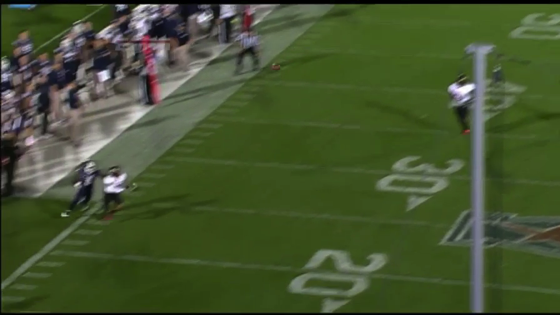
The receivers reliably caught the ball and did a solid job of finding holes when Maryland played zone. They don't seem to be particularly explosive.
One interesting thing UConn tried was one of the packaged plays that are en vogue in football these days. While it didn't actually work, the Huskies called for a stick/draw (scroll down to #2 here), in which the tight end runs a quick stick route—if the linebacker responsible for the TE stays home, the QB hands off to the RB on a draw. In this case, Maryland had the stick covered and brought a corner blitz from the other side, so Whitmer was damned if he did, damned if he didn't:
Here's a still of the mesh point; you can see the TE is well covered while the RT has been driven back practically into the RB:
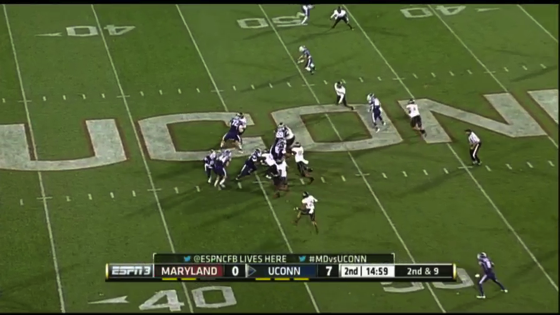
Yes, two receivers are very, very open; passing to either of those players would've taken quick-thinking improvisation on the part of Whitmer, as this is supposed to be a very fast, one-or-the-other read. Maryland had the right defense called for this play; it'll be interesting to see if Michigan does as well in defending the concept.
PLAY BREAKDOWN
Why is UConn so bad at running the football? Besides being quite predictable, I just don't think McCombs is very good. Here's one example as UConn tries to run an inside zone out of a heavy ace formation. The pre-snap setup, in which you can see that the Huskies easily have the numbers to block this play up front:
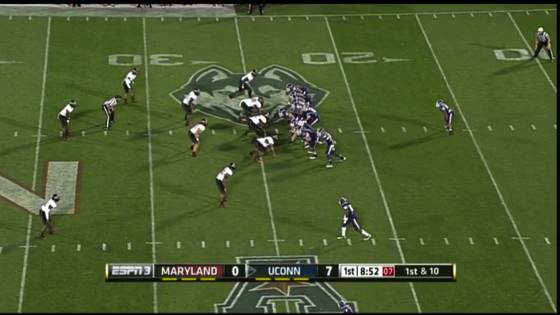
At the handoff, UConn has already managed to take care of Maryland's defensive line with single blocks and two linemen are headed for the second level. The backside of this play is wide open for a cutback:
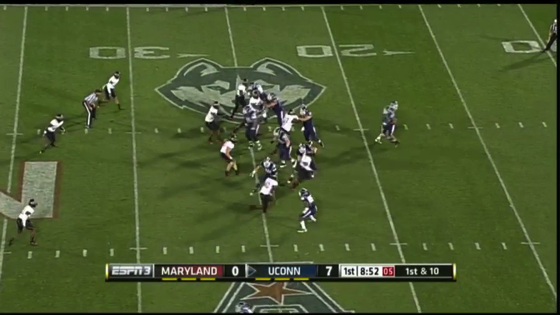
It looks like McCombs recognizes this, as he starts to head to the outside. The Maryland safety isn't even roaring down to the line to prevent this and both defensive linemen—plus a linebacker—are getting manhandled:
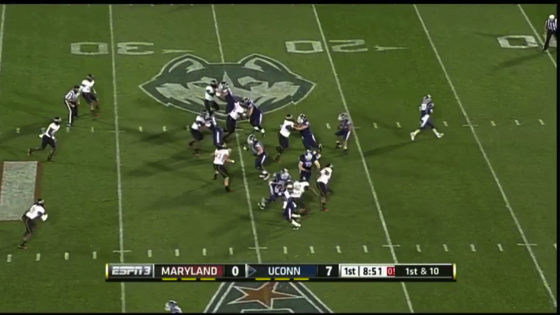
Instead of sticking his foot in the ground and taking off, however, McCombs does a little shuffle step and essentially doesn't move, allowing a couple Terps to begin to shed blocks:
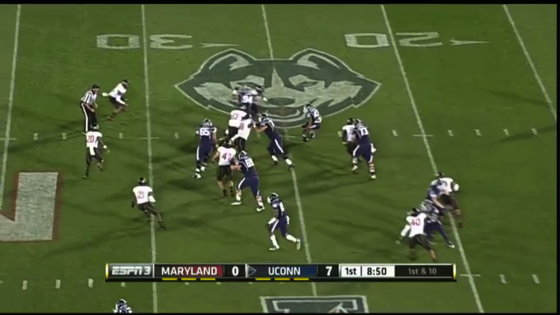
After running himself into trouble, McCombs is forced to dive ahead for a relatively small gain:
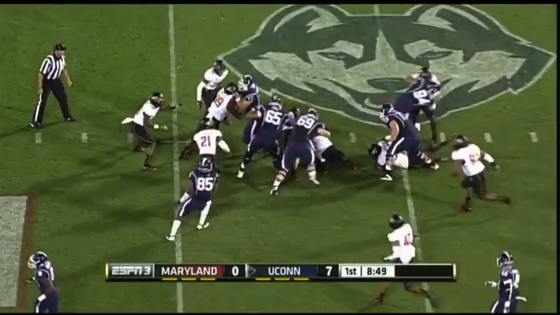
Video:
In a zone running scheme, you don't want your back to do a "jitterbug step"; if not for the Maryland lineman tackling McCombs forward, he barely would've gained a yard on this play, and he had plenty of space to the outside if he'd just cut hard and go. This isn't on the line, which did a great job of blocking the play. This is all about the back not taking advatage of what he has. McCombs has received all but four of UConn's running back carries this season and he's averaging just 3.6 YPC.
DEFENSE

MIKE Yawin Smallwood is a legit NFL prospect
Base Set? 4-3, though UConn would often lift a defensive tackle instead of a linebacker when they went to their nickel set. They didn't always do this when it made actual sense. Note the down:
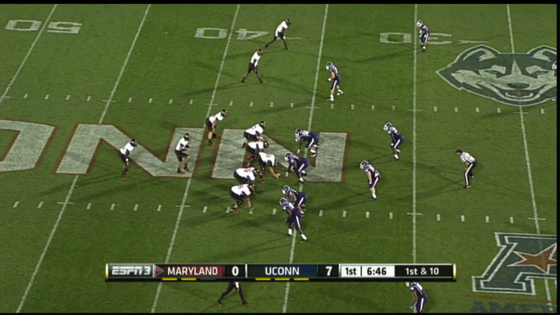
Maryland ran inside to the left for an easy 14 yards because, I mean, just look at that alignment, and then tell me where the safeties are (hint: off the screen, playing a two-deep shell).
Man or zone coverage? UConn mostly played soft zone coverage with two deep safeties. They insisted on playing their safeties deep even as Maryland continually gashed them with the run. This is a fairly typical setup:

UConn is down 14 in the fourth quarter and Maryland is in a three-back pistol set, yet the Husky safeties are lined up 10 yards off the LOS and their corners are playing soft. I... don't understand this.
Pressure: GERG or Greg? Totally GERGian. UConn did that infuriating thing where they'd rush three on third down, generate zero pressure, and let the opposing quarterback pick them apart. Sound familiar? If you haven't blocked out large portions of your memory, the answer is yes.
Dangerman: MIKE Yawin Smallwood is the lone returner from what was one of the country's better groups of linebackers last year, and he was all over the place on Saturday, recording 15 tackles and generally being the only thing between several Maryland sweeps and easy touchdowns. He also had one of the more impressive zone drops I've seen in a while:
I be like dang.
OVERVIEW
UConn is relatively stout up the middle with Smallwood and defensive tackles Shamar Stephen and Julian Campenni and strongside end Jesse Joseph; all of those guys made impressive plays on interior runs, and Maryland really couldn't get much going up the gut.
They didn't have to, however, as the outside was routinely open for big yardage. This was mostly on the outside linebackers, who were hesitant when they needed to get on their horse and go, then overpursued on play fakes. Outside linebacker Graham Stewart (#2) hesitates just long enough on this speed sweet to get himself cut to the ground, allowing one of many big gains by Maryland to the edge:
Most of Maryland's 224 rushing yards came in this manner—getting to the outside quickly—with the main exception highlighted in the play breakdown at the bottom of this post.
The pass rush was pretty much non-existent. In fact, it was non-existent: UConn didn't record a sack and weren't credited with a single QB hurry on Maryland's 28 pass attempts. They haven't sacked the quarterback once this season. Again, their other game was against Towson.
This really hampered the secondary, as it's tough to stay with receivers when playing a soft Cover 2 while the quarterback has all day to throw. The non-Smallwood linebackers routinely failed to get enough depth on their drops, leaving the middle of the field wide open for solid gain after solid gain. Maryland barely had to test UConn's corners, so I didn't get a great read on their ability, nor did they have to go over the top of their safeties. They got a big gain towards the end of the first half when a corner vacated his zone, leaving a Terp wide open on the sideline; Maryland probably would've turned that possession into a touchdown had they not run out of time in the half—instead, they settled for a short field goal. The safeties did a solid job of tackling; they needed to, as a lot of plays ended up in the secondary.
PLAY BREAKDOWN
This play is relevant to your interests:
This is the play pictured at the top of the post. Maryland runs an inverted veer. UConn crashes their DE and brings two linebackers off the edge, so this play should be dead to rights. Smallwood (#33) goes after the back, leaving only Stewart (#2) to take the quarterback. He, well, doesn't do this well. The play busts for a touchdown when redshirt freshman safety Obi Melifonwu takes a horrible tackling angle, leaving the middle of the field wide open.
More inverted veer, please.
September 19th, 2013 at 8:42 AM ^
I will go back and live in a world where I think UM can lose to everybody and believe it till the final whistle or the backups are in. No more predictions from me dagnamit I've learned my lesson.

September 19th, 2013 at 9:04 AM ^
September 19th, 2013 at 9:20 AM ^
with the subs all in by the second quarter. If there ever was a game we can take for granted it's this one.
September 19th, 2013 at 9:32 AM ^
This has been called the biggest game in UConn football history. We'll get their best.
September 20th, 2013 at 9:53 AM ^
September 19th, 2013 at 9:43 AM ^
This will be a complete obliteration game. I have no clue where UCONN plays their games. But I should be able to find out Sunday morning by just looking for the gigantic crater. My prediction is Michigan wins 3 gazillion and 1 to -47. This team is so bad I think Pattricks pet rocks would be favored by 2 TD's.
September 19th, 2013 at 11:32 AM ^
I hope that
The O-line will create some running lanes, and that Fitz will recognize them
The D-line will create some real push, and sack Chandler Whitmer, Esq. a few times
D. Gardner, Esq. will only complete passes to his own teammates
R. Taylor will not play the entire game with a target on his jersey, and that said jersey will not be reduced to ashes before game end.
Just as the future lies before us, the past lies behind --- forget about it! M by 21.
Comments